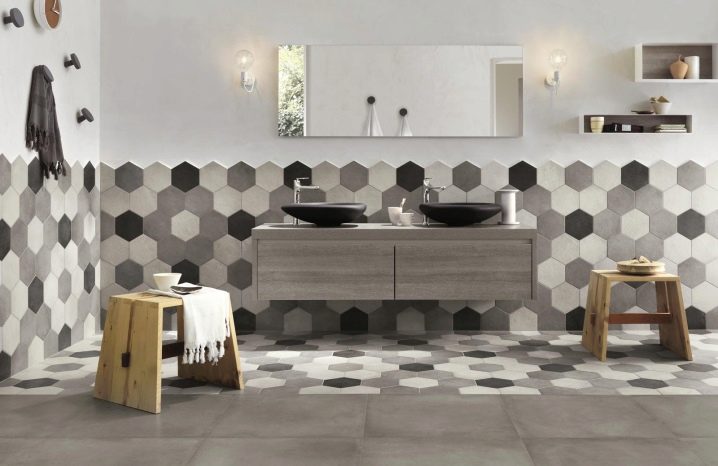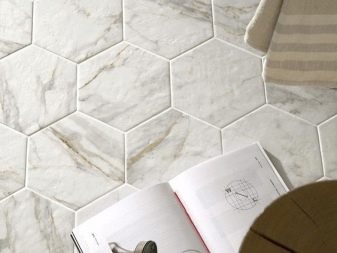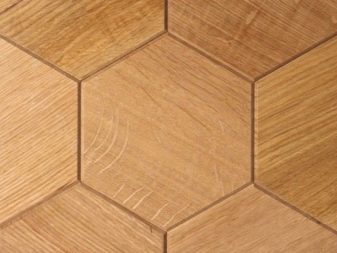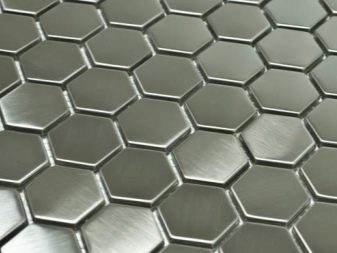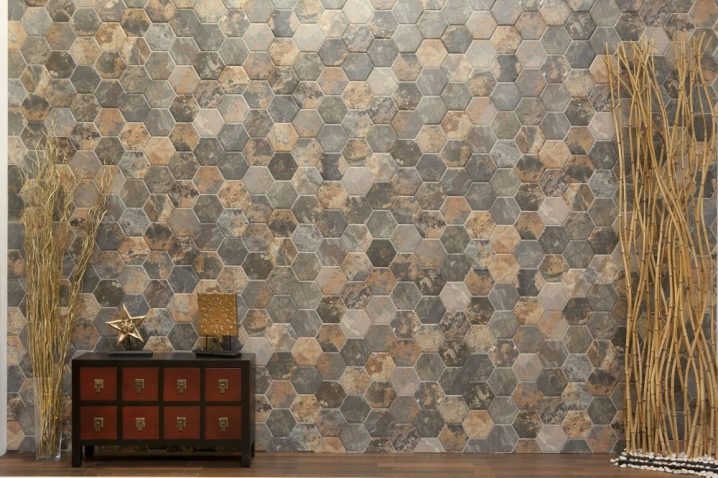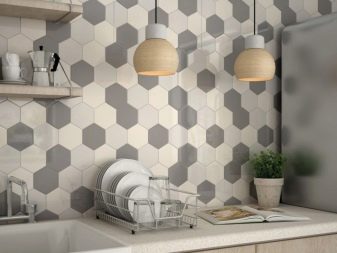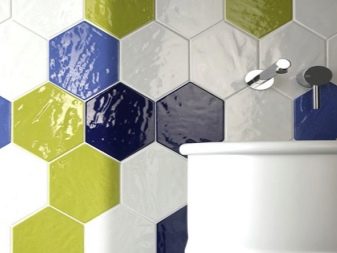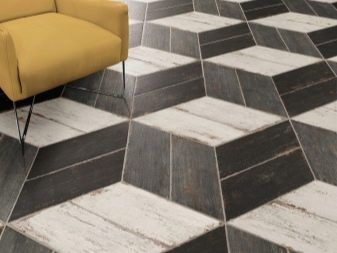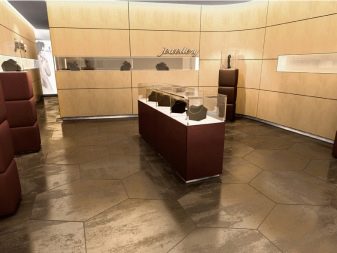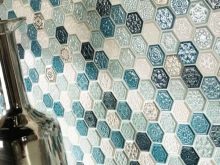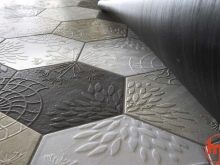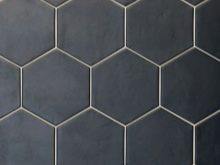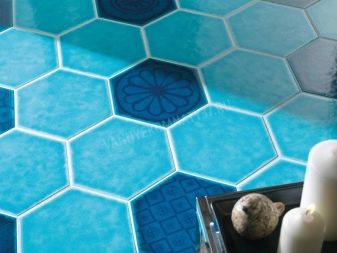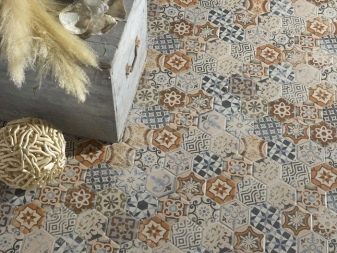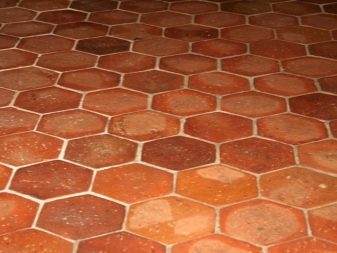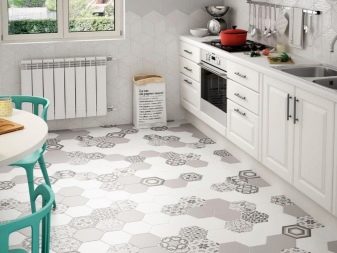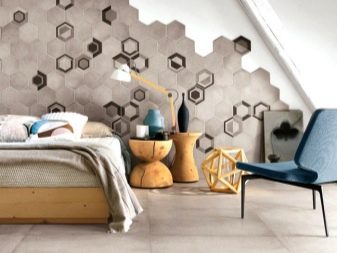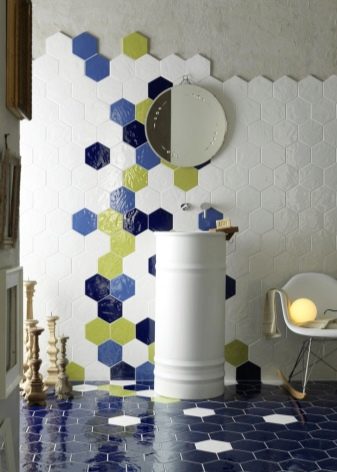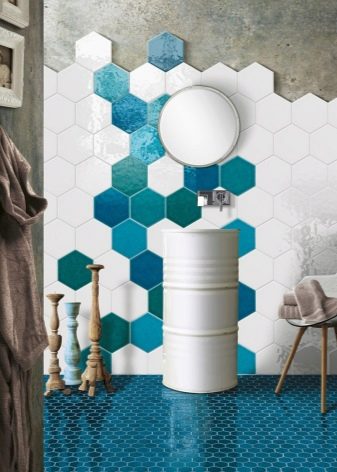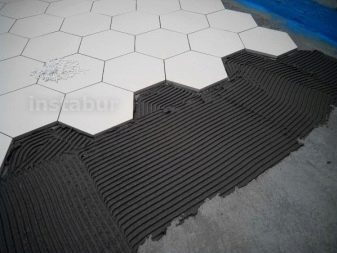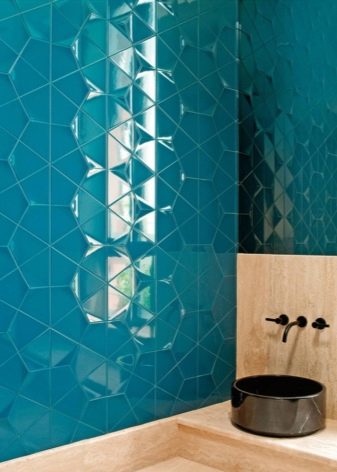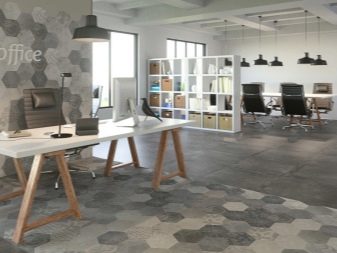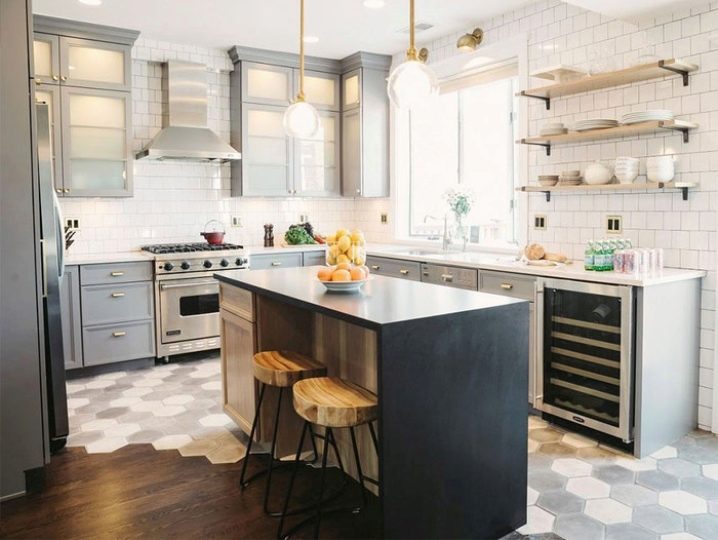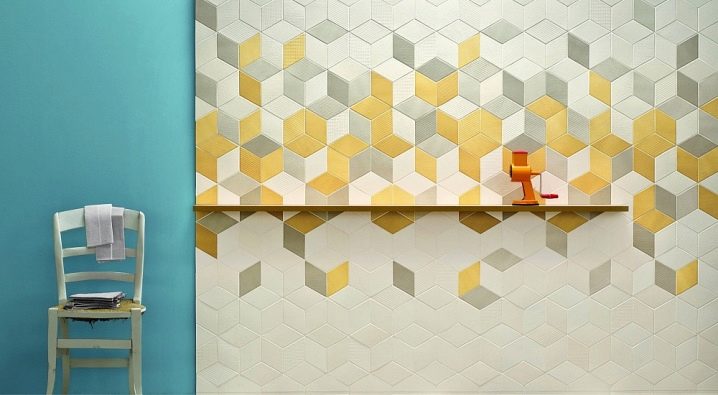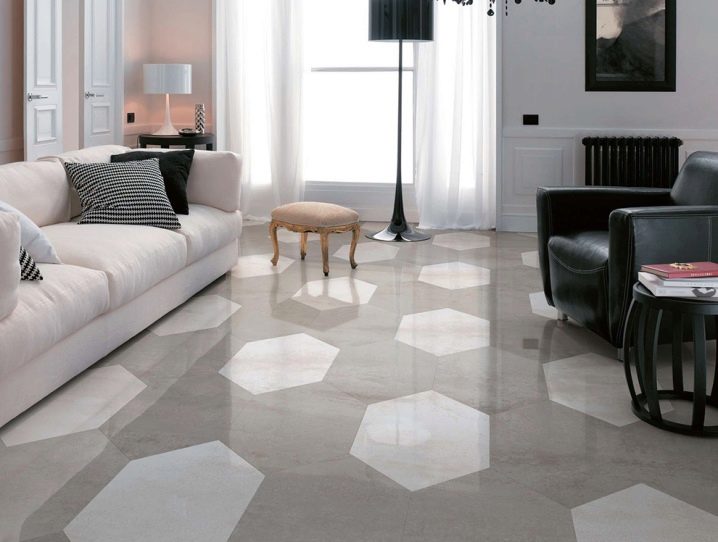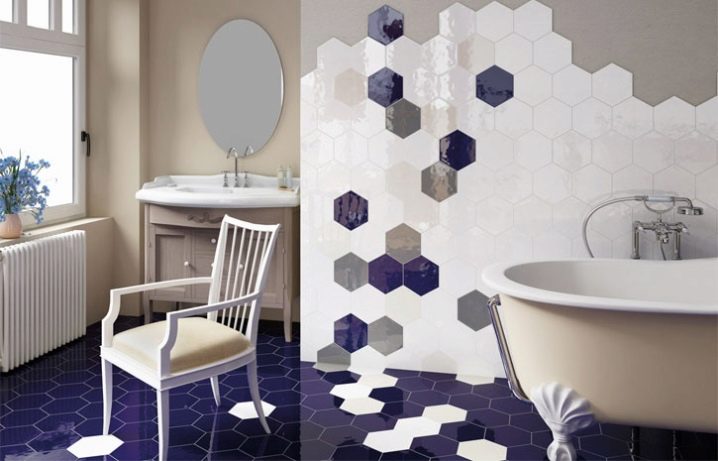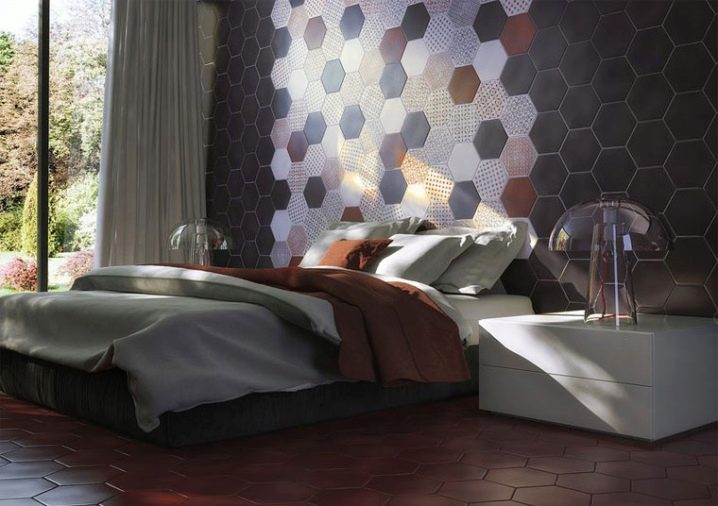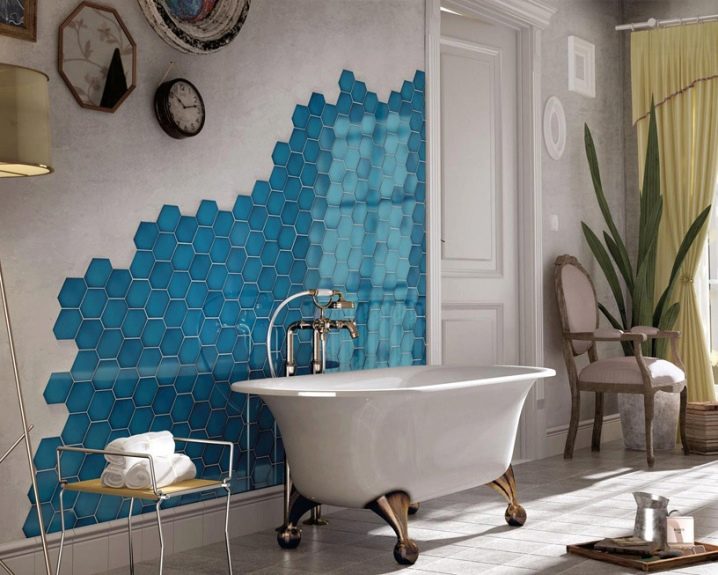“Honeycomb” tiles: shape features and application in the interior

The tile covering in the form of a hexagon is not only practical, but also unusually beautiful. This material will look great in a variety of styles of interior design. In this article, the features of the form and the use of such stylish material in the interior are discussed in detail.
Distinctive characteristics
The hexagonal tile is quite different in its unusual shape from the usual squares or rectangles. Polyhedrons are used not only as a floor or wall covering, but also to create separate decorating elements.The variety of shades, structures and materials allows you to create original compositions and unusual effects using the “honeycomb” model.
In addition to polygons of the correct form, models are produced in the form of an irregular elongated hexagon. Hexagon tile can be combined with square and rectangular models, which allows you to create original cover.
With the help of polygons, you can visually combine the space in the room, creating interesting transitions from the floor to the walls.
Many manufacturers are ready to make hexagon tiles of any shades to order. Hexagonal tiles are made not only in a wide variety of color variations, but also with imitation for many types of materials and surfaces:
- laminate or parquet;
- concrete;
- marble;
- metal;
- tree;
- leather.
Kinds
Manufacturers of hexagonal coatings produce a wide variety of options that may differ in some characteristics. Basically, the differences are as follows:
- the size;
- texture;
- material;
- Colour.
Coverage sizes can be either miniature (convenient to use for decoration) or rather large (for laying sidewalks). Consider the most common dimensions of the "cell" model:
- 6.5 x 7.5 and 15 x 17 centimeters. With the help of products of small sizes it is convenient to decorate certain sections of the walls and floor.
- 25 x 21.6 centimeters. In this format, mainly produced European tiles with different patterns and patterns on the surface.
- 36 x 41.5 centimeters. This size has a popular matte tile for wood. The material can be used for finishing both inside and outside the room.
- 36 x 42.5 centimeters. With such parameters make a special tile for the street.
- 28.5 x 32.5 and 36 x 41.5 centimeters are standard sizes of hexagonal terracotta tiles.
- 51.57 x 59.55 centimeters. This size has the original tile under the metal. Used as a wall covering.
The thickness of the multi-faceted tile can be in the range from 5 to 14 millimeters. As a floor covering it is better to use a material from 7 to 10 millimeters thick.
The texture of the hexagonal coating depends on the method of production of the material. There are hexagons with the surface of the following types:
- Smooth glossy. In the manufacture of such tiles is glazed. Thanks to this processing technology, the surface of the material is smooth and shiny.This type of coating is rather slippery. This material should not be used for finishing the floor in the bathroom or in the kitchen.
- Matte. In the production of this type of tile, glazing technology is not used. This surface is not slippery, but may have a porous structure (depending on the method of production of the product).
- Relief rough or glazed.
- Polished stoneware tiles. Externally, this material resembles marble or granite stone. During the processing of this material, the outer layer is removed from the tile. For this reason, this coating does not have high strength and durability.
- Laminated (semi-polished) porcelain. It turns out by means of surface polishing of hexagons. In contrast to polished porcelain, has a higher technical characteristics.
By combining material with a different structure, you can implement interesting design solutions in the interior of the room. Among the variety of sizes, shades and structures can distinguish several popular models of hexagonal tiles:
- universal monophonic;
- with a pattern or pattern;
- patchwork;
- imitation for various materials;
- terracotta
Advantages and disadvantages
Hexagonal tiles are no doubt different in their appearance from other types of tile coatings. The main advantages of hexagons are as follows:
- attractive appearance;
- large selection of shades and textures;
- available in various sizes;
- variety of layout options.
Specifications of a particular hexagon model will directly depend on the method of production and the material of the product. Most often, in the form of honeycombs manufacturers produce tiles. Like other ceramic tile options, the hex tile has the following qualities:
- high strength;
- wear resistance and durability;
- resistance to temperature extremes;
- fire resistance;
- resistance to stress;
- moisture resistance.
Compared with the tiles of the usual forms, polyhedra have some drawbacks.
Highlight the main disadvantages of this material:
- There may be some difficulties when laying the coating. Working with the material of a standard form (rectangle, square) is much easier and more convenient.
- The cost of hexagon tiles is higher than the cost of tiles of standard shapes and sizes.
For different rooms
The hexagonal tile differs in a variety of the sizes and color schemes. Such material will look great in the premises of various purposes.
In the bathroom, tiled flooring of standard forms has become familiar and looks already unoriginal. A great alternative to square and rectangular tiles will be a coating in the form of small hexagons.
The six-sided tile can have both an equal, and convex surface. As a floor covering in the bathroom, it will be more practical to choose a matte smooth tile.
If the material is used to decorate individual sections, structural tile will look more effective.
Hexagons, which are visually similar to concrete or cement, are popular. Such models look quite original and create a warm atmosphere in the room. These materials will look great not only in the bathroom, but also in the bedroom.
Hexagonal tiles are more and more often used to decorate the kitchen in such interior design styles as loft or high-tech.White and gray tones are perfectly combined with wood and metal decorative elements.
Tile "honeycomb" harmoniously looks not only in industrial interiors. In the bright and cozy kitchen, you can lay out an apron of small hexagons. Hexagonal tiles on the surface can have a variety of patterns. Such models of coverage will make the interior design more unusual and attractive.
Floor finish
Due to the special shape, it is possible to obtain an almost seamless surface when laying the “honeycomb” tile. Also with the help of this material it is convenient to zone the space. With the help of hexagons it is convenient to form smooth transitions in the room. Using this approach, it is possible to divide the working kitchen and dining areas in the studio apartment.
The effect of expensive floor will help create a multi-faceted ceramic tiles with imitation of a granite stone or marble. Particularly attractive is the patchwork tile pattern. In one finished batch of such material there will be tiles with a different pattern or pattern.
Laying tile patchwork modules does not require adherence to special rules for combining images on the floor.However, a well thought out tile composition will look more impressive.
Before using hexagons in the patchwork style of bright colors, you need to pay attention to other elements of the interior and the color palette of wall decorations. It is desirable that the color of the walls be uniform and harmoniously combined with the shade of the tile.
You can spread interesting carpets and compositions not only from tiles with different patterns, but also to combine polyhedrons with other materials. It will be interesting to look at the combination of hexagonal tiles with laminate.
Wall covering
Hexagons are rarely used for cladding the entire surface of a wall. Basically, this material is used for decoration of individual sections or as the creation of decorative wall panels.
The technique of creating asymmetry or smooth transitions in finishing with the help of polyhedra is popular.
By combining hexagons of different colors, you can create separate compositions or focus on areas of uniform color. White polygonal tile looks great in combination with modules of dark shades.
Model patchwork for wall cladding is used no less than for flooring.The whole wall or its part can be decorated with a mosaic of hexagons, which are harmoniously combined in hue. For wall cladding, a special model of hexagonal tiles is produced, which has a volumetric convex surface. With this coverage, you can create interesting 3D effects.
How to choose?
Manufacturers of tile coatings are ready to offer a wide range of hexagonal models. You can choose the appropriate option for the interior of any style. When choosing, consider the following:
- room size;
- interior design style;
- surface to be laid (floor or walls);
- purpose of the room.
As a flooring in a room with a large area is to use hexagons of large sizes.
When buying a material you need to remember that when laying the coating a large number of tiles will have to be cut. For this reason, it is necessary to acquire hexagons with a rather large margin.
Beautiful examples
Combining hexagons of different colors, you can create bright accents on the main background.
The original wall covering is made of tiles that differ in color and pattern on the surface.
Modules of hexagons of various colors form a harmonious composition with repeating patterns.
Wood polyhedrons are great for decorating individual sections of the wall.
Hexagon tile is not necessary to spread on the whole wall. Partially revealing the surface looks quite unusual and attractive.
Glass tile with metal modules will be an excellent option for finishing the kitchen apron.
See below for how to dock the hexagonal tile and laminate.
